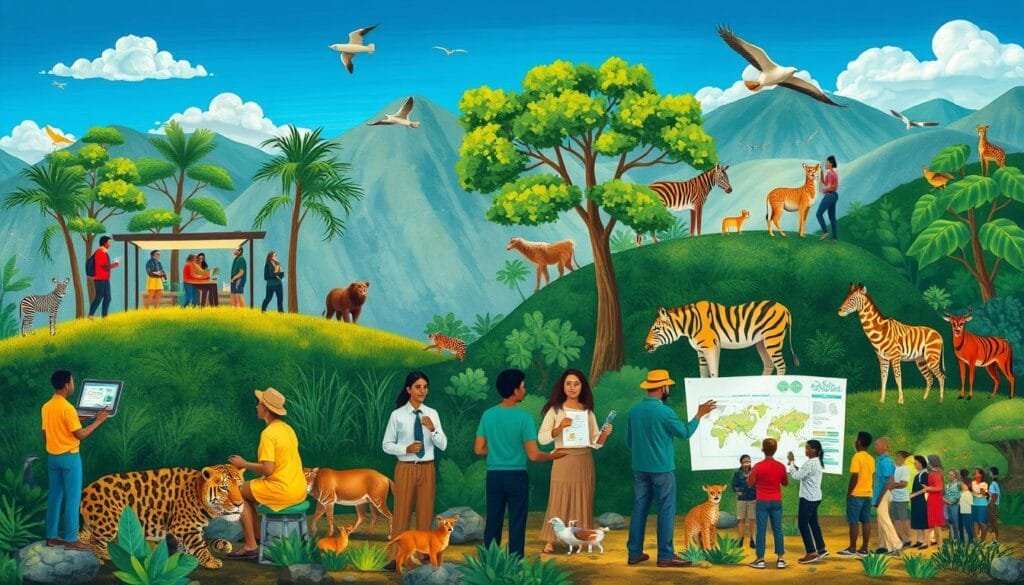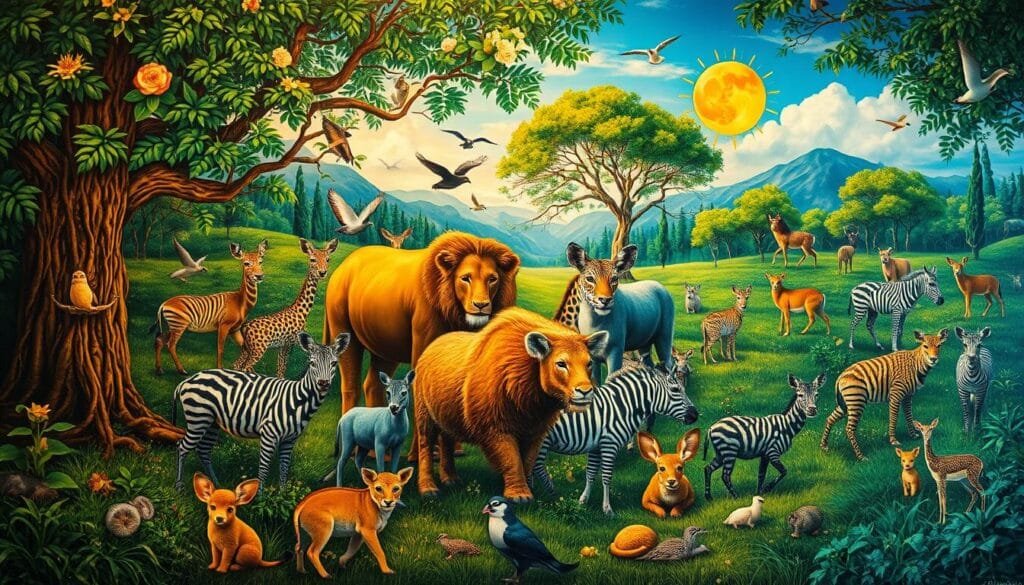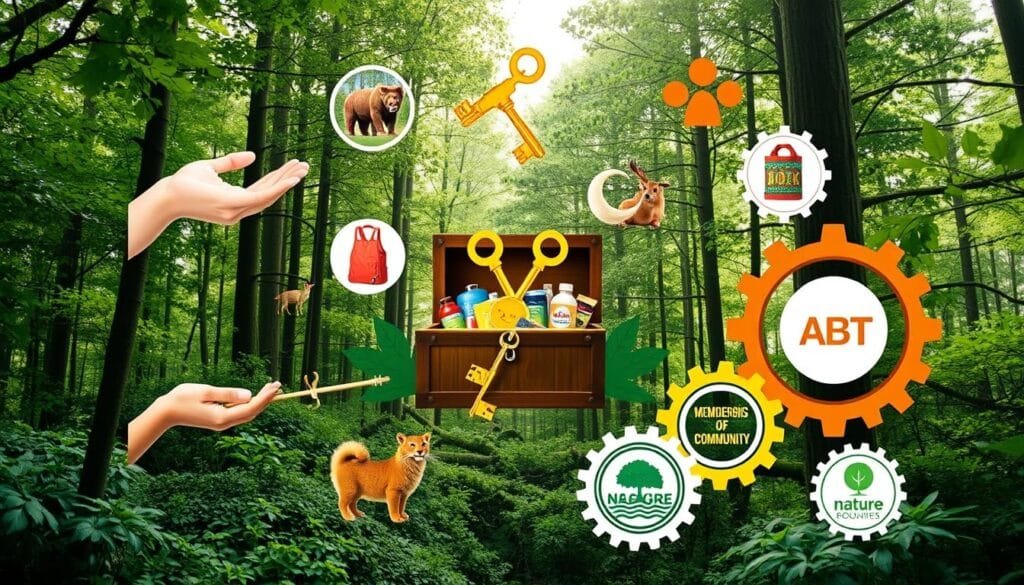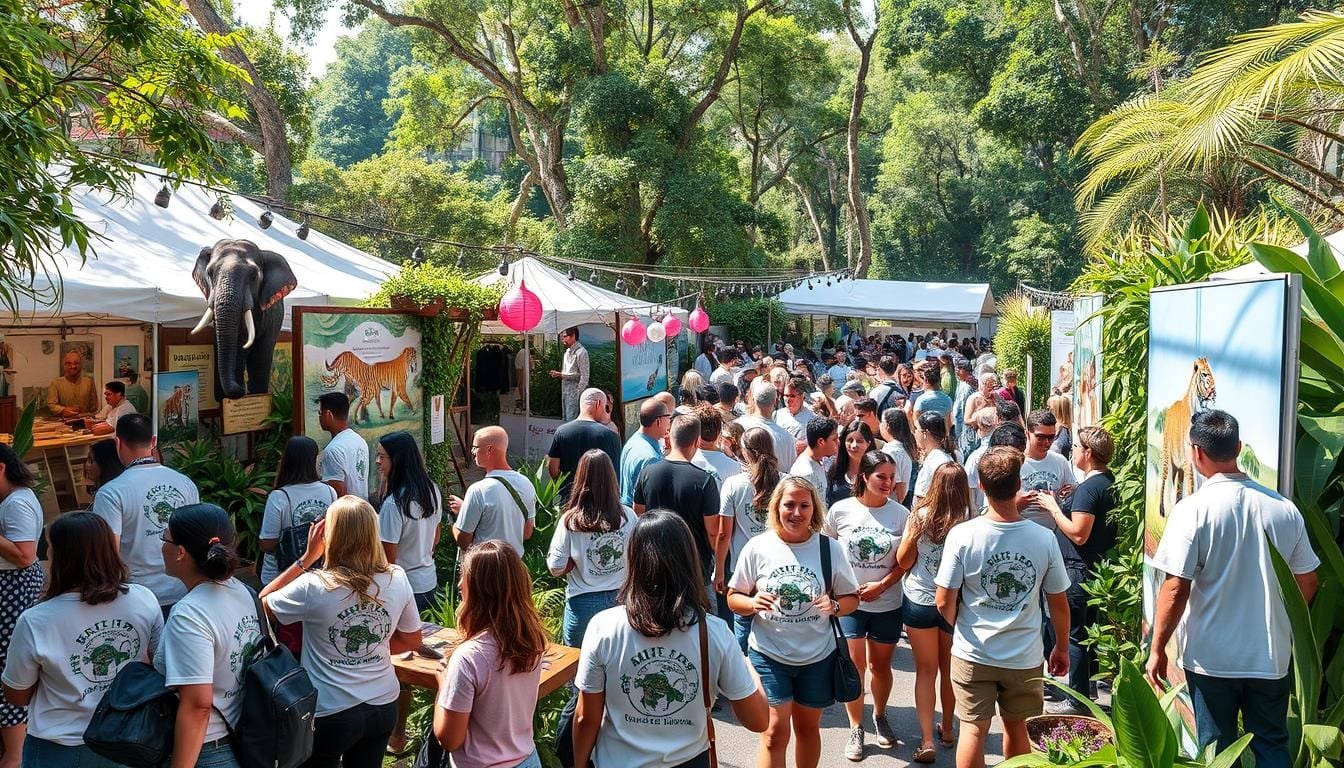The Wildlife Conservation Society (WCS) works all over the world. Places like New York and Madagascar get their help for a big reason. They want to keep nature rich and alive and help people live sustainably. In places far and wide, WCS is a big player in making rules for nature protection. They work closely with governments too.
How does WCS get money for its projects? It’s not just about asking for funds. They teach communities why nature is worth saving. They talk about the good stuff nature gives us. Like clean air, fresh water, and safe homes for wild animals. All these are vital for our health and happiness.
Key Takeaways
- WCS focuses on global biodiversity protection and sustainable development.
- WCS’s expansive presence includes strategic partnerships with governments and communities.
- Educational initiatives underscore the importance of nature’s ecosystem services.
- In 2022, WCS received $4.8 million in donations, with 32% from Canadian government funding.
- The organization maintains a strong fiscal responsibility, with 85 cents of every donated dollar going directly to conservation efforts.
The Importance of Wildlife Conservation
Wildlife conservation is vital for keeping our planet’s diversity and supporting human and economic health worldwide. The Wildlife Conservation Society (WCS) works to protect key habitats, save biodiversity, and manage natural resources sustainably. These actions help provide the ecosystem services that global populations rely on.
In Oregon, 88 percent of species are neither hunted nor fished. Yet, the Oregon Department of Fish and Wildlife (ODFW) focuses mainly on game species. Since general and lottery funds make up just 10 percent of its budget, more funds are clearly needed for saving species and their homes.
Putting money into wildlife conservation brings big benefits. It helps capture carbon, fighting climate change, and makes farming more productive. It even reduces the impact of natural disasters. All this shows why we need to manage natural resources in a smart, integrated way.
Conservation is also good for the economy, thanks to ecotourism. Conservation areas not only bring in money and jobs but also help communities grow. Also, being around nature can make people feel mentally better, easing stress, worry, and sadness.
Still, the agencies that look after these places often don’t have enough money. 48 percent of the ODFW’s funds come from hunting and fishing, but it’s not enough to take care of all wildlife needs. We must find new ways to get money, like extra charges on products or travel, to help protect wildlife and habitats better.
| Agency Funding Source | Percentage Contribution |
|---|---|
| General and Lottery Funds | 10% |
| Hunting and Fishing License Sales & Excise Tax | 48% |
| Other Sources | 42% |
Ultimately, wildlife conservation is crucial for our world’s health. By safeguarding ecosystems and managing natural resources wisely, we help local and global communities. More support and funding for these activities are essential to keep our natural world thriving and healthy.
WCS Funding Strategies and Platforms
We work with various methods to protect wildlife and natural spaces effectively. We look after an impressive 4 million square miles of land and sea, which includes 2 million acres of protected areas. These efforts help us save many ecosystems and the species that live there, like gorillas, tigers, sharks, and elephants.

Discover and Research
Our work starts with deep research in places rich in biodiversity. This scientific work is the backbone of our conservation efforts, helping us make sure our actions hit the mark.
Inspire Conservation Action
We also aim to spark a love for nature in people through education and getting them involved. We use our zoo network, the biggest in the world’s cities, to teach millions about the importance of caring for wildlife.
The following table outlines key statistics about WCS’s conservation efforts and partnerships:
| WCS Conservation Efforts and Partnerships | Details |
|---|---|
| Global coverage | 5% of the earth’s surface, covering half of the planet’s biodiversity |
| Protected areas | 2 million acres |
| Iconic species | Gorillas, tigers, sharks, elephants |
| Ongoing initiatives | Climate change, wildlife health, illegal wildlife trafficking |
| Staff members | 3,700 |
| Annual visitors (NYC wildlife parks) | Over 4 million |
| Global project count | Over 500 |
| Partnerships | The Walt Disney Company, Mitsubishi Corporation Foundation for the Americas, The Tiffany & Co. Foundation |
Our diverse funding strategies, coupled with effective finance methods, allow us to support crucial wildlife protection. This commitment to conservation leads to significant improvements in environmental sustainability and the protection of biodiversity.
Corporate and Philanthropic Partnerships
Many corporations and philanthropic groups are key to helping wildlife conservation. They use their resources and social responsibility to support this cause. The Walt Disney Company is a prime example of this support. Disney has invested $120 million in non-profits that work with communities to protect wildlife. This funding has helped save elephants, tigers, and various marine species.

The Mitsubishi Corporation Foundation for the Americas is another major supporter. They have been helping the Wildlife Conservation Society (WCS) since 2003. The foundation appreciates WCS’s work in connecting research with real environmental improvements. One of their notable projects is the Amazon Waters Initiative.
| Partner | Initiative | Support Details |
|---|---|---|
| The Tiffany & Co. Foundation | Marine and Coral Conservation | Focuses on sustainable practices and research critical for addressing climate change. |
| Fahlo | Endangered Species | Donated over $3 million to global conservation partners. |
| Loopy for a Cause™ | 1% Pledge Program | Donates 1% of total revenue to partnered organizations each year. |
| Leonardo DiCaprio Foundation | Lion Recovery Fund | Committed $1 million to protect lions. |
| LOEWE & Knot On My Planet | Elephant Mini Bags | Launched a limited edition collection to save elephants. |
These partnerships show how organizations can really make a difference. By focusing on corporate responsibility and giving to conservation, they protect our planet. It helps keep our most important species and places safe for everyone.
how does wildlife conservation society make money
The Wildlife Conservation Society (WCS) raises money in many ways. This helps them continue their work to save wildlife and habitats.

One big way WCS gets money is through donations from people. These people want to help save animals and nature. Companies also team up with WCS. This partnership brings funds and ideas to help with conservation.
- Grants from the government are important too. They fund projects to protect land, water, and animals, which is essential for WCS’s work.
- Money also comes from things like parks and tours. These activities create jobs and pay for conservation, with big financial benefits for communities.
WCS started a project called Ibis Rice in 2009. It helps communities in Cambodia by selling special rice. The Conservation Enterprise Development Program helps communities too. It gives them support to start conservation businesses.
Investing in conservation has big returns. For every dollar spent, there’s a four dollar gain. This shows that saving nature is also good for the economy.
In Colombia, WCS works to balance nature and development. They protect special places for animals like the Andean bear. This helps keep nature safe even when new projects are built.
WCS also studies how Conservation Trust Funds work worldwide. They started this in 2006. It helps them and others invest better in saving the planet.
The wide range of ways WCS funds its mission shows their commitment. They use donations, business ideas, and more to help wildlife and places stay wild.
Conclusion
Reflecting on the Wildlife Conservation Society’s (WCS) work shows how vital non-hunter support is. About 94% of U.S. conservation funding comes from these contributors. This highlights the big role of WCS and similar groups in conservation.
Looking to the future, non-profits are at the forefront of wildlife protection. They get 87.7% of their funds from non-hunters. Together, federal agencies and non-profits have given an impressive $21.143 billion. This emphasizes the ongoing need for conservation to ensure sustainability. Yet, funding challenges and the need for better technology and business models remain.
Going forward, the partnership between public and private sectors is key for wildlife protection. With WCS’s innovation and the support from various funders, our unified efforts are crucial. By joining forces in funding and innovation, we can create a lasting impact on conservation. This teamwork will help protect our world’s biodiversity for the next generations.
FAQ
What is the mission of the Wildlife Conservation Society (WCS)?
WCS aims to save wildlife and natural habitats. We care for over two million acres across many protected areas. Our work includes saving animals in danger of extinction, like gorillas, tigers, and sharks.
How does WCS inspire conservation action?
We use education and community involvement to encourage everyone to help with conservation. This helps people feel a stronger bond with nature. It also leads to better care of our planet by communities.
How has the Mitsubishi Corporation Foundation for the Americas supported WCS?
Since 2003, the Foundation has backed our research that leads to real environmental benefits. A big project they’ve supported is the Amazon Waters Initiative.
What role does The Tiffany & Co. Foundation play in supporting WCS?
The Tiffany & Co. Foundation helps us with projects that protect the oceans and coral reefs. They focus on sustainability and research. This is vital for tackling big issues like climate change.
How does WCS fund its conservation efforts?
Our funding comes from several sources. This includes corporate partners, donations, government grants, and fundraising events. Such support helps us in our mission to protect animals and nature.
Why is wildlife conservation important?
Keeping wildlife safe is key for biodiversity and good use of natural resources. It ensures the survival of various species. Plus, it keeps ecosystems healthy for the benefit of human communities.
What strategies does WCS use to secure funding for its initiatives?
We seek donations, partner with companies, apply for government money, and create unique fundraising activities. These tactics help us keep going with our conservation projects.
How do corporate and philanthropic partnerships benefit WCS?
Partnerships bring the funds and resources we need to grow our conservation work. Organizations like the Mitsubishi Corporation Foundation for the Americas and The Tiffany & Co. Foundation are key supporters of our cause.
